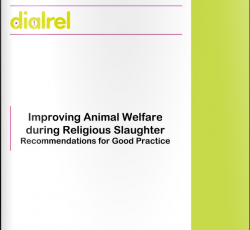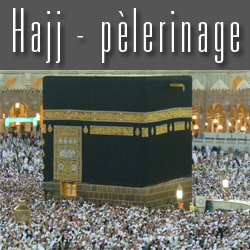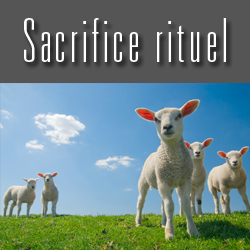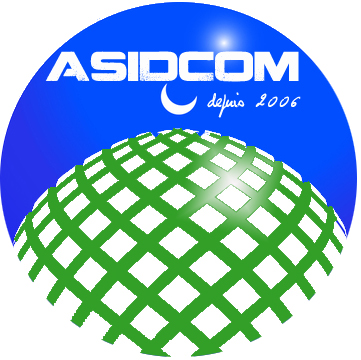DIALREL recommendations : comments of Pr Regenstein

( français
![]() )
)
We received a copy of the comments of Pr Joe M. Regenstein on the latest version of the DialRel Document “Main outcomes and recommendations to good animal welfare practices during religious slaughter” . So we would like share them with you.
Comments on the latest version of the DialRel Document “Main outcomes and recommendations to good animal welfare practices during religious slaughter”
Submitted by Joe M. Regenstein, Professor of Food Science, Cornell University, Ithaca, NY 14853-7201, USA. [email protected].
This document remains a work in progress and still needs to address some important issues. My comments were originally put directly on the document and are now copied over. They have not been edited since the original submission. I would be happy to discuss these items with any appropriate person.
Page 2 (of 12), 1st Paragraph :
“The implementation has been achieved by consultations, gathering, exchanging and reviewing information and networking. More details on the project can be found on the website www.dialrel.eu.”
Actually I’m concerned that the implementation has been hindered by the approach taken, which has left many in the religious community feeling that the project was more of a monologue than a dialogue. Only towards the end did the group even begin to engage the religious community seriously. The document still fails to be respectful of religious law and the need to work WITH that community to improve areas that don’t challenge the religion rather than an attempt to prove that religious slaughter is somehow inferior to other forms of slaughter. The lack of critical evaluation of much of the scientific literature, which has to date not separated good from bad religious slaughter remains the critical flaw in the scientific analysis.
Page 2, 2nd Paragraph :
“The present document contains a number of recommendations from the viewpoint of veterinary sciences on practices related to religious slaughter.”
A. Why is it totally veterinary sciences and not a broader look at the issues from the multiple scientific disciplines that cover animal welfare ?
“It is based on best available knowledge :…”
B. It is clear that we don’t have a lot of scientific knowledge and a lot of it is based on an incomplete or non-existent description of the actual slaughter practices so the merit of the work cannot be judged. When scientists such as Mohan Rao or Neville Gregory respond by saying that he does not know the details of the religious slaughter, then the "religion of science" has serious problems. Some years ago the Swedish Royal Veterinary Society clearly visited the WORST possible plant in the UK and used that the justify their ban on religious slaughter. That isn’t science - that is agenda politics.
Page 2, 4th Paragraph
“The document represents the views of the authors and does not necessarily represent a position of all the delegates present at the scientific workshop on religious slaughter practices”
A. Has each one actually signed off on this and is prepared to support everything in it ?
“Literature and scientific evidence used in this set of recommendations are based on best available knowledge from peer reviewed publications and the longstanding experience of the authors who have observed significant numbers of animals at European slaughterhouses, both religious and non-religious facilities.”
B. That is a cop-out. A lot of the peer-reviewed literature is reviewed by people with the same belief system as those writing it. And given that none of the European slaughterhouses are close to the level of the best slaughterhouses in North America (based on discussion with Dr. Grandin), the issue of improvement of many slaughterhouses is fine. The idea that those facilities represent a base for evaluating religious slaughter as such is part of the fallacy that the scientific community has failed to address. There are bad religious slaughter houses and good ones just as there are good and bad regular slaughter houses.
Page 3, 1st Paragraph
“As reversible stunning is also accepted by some Muslim Communities, recommendations for pre and post slaughter stunning are also included.”
As long as it can be proven that the animal is alive and the actual slaughter cut is killing the animal.
Page 3, 2nd Paragraph
“The recommendations are intended as a proposal to improve animal welfare during religious slaughter, taking into account the existing legislation and the religious slaughter requirements in the general context and in the case of specific incidents.”
This is a major limitation of the work. It is disrespectful if it does not carefully consider religious requirements. How many of the authors on this document could give a systematic and complete talk on the rules for both kosher and halal slaughter, particularly respectfully discussing some of the disagreements within the religious communities and therefore providing carefully for working with each community to optimize the slaughter within the rules each community needs to operate within ?
Page 3, 3rd Paragraph
“All facilities should develop effective working and training procedures.”
And how much of the so-called peer review literature in all aspects of slaughter, both religious and non-religious, actually describe and monitor these factors as part of any subsequent study of the actual act of slaughter. All of these items need to be done well before the impact of the religious slaughter act or of stunning can even be considered.
Page 3, 5th Paragraph
“Specific training of slaughtermen and abattoir staff including management in key areas (such as animal handling, restraint, knife sharpening, animal physiology, signs of stress and pain, times to unconsciousness and signs of loss of consciousness) is vital to ensure good animal welfare.”
Footnote : In this document the term consciousness is synonymous with sensibility and unconsciousness is synonymous with insensibility.
Page 3, End of Page
“However, this position may require greater skill to achieve an appropriate cut and manage the post-cut period”
Using a proper head holder has minimized the problem once a slaughterman is trained to do upright slaughter. Further work to create ergometric knives that are religiously acceptable but take into account the different positions possible for religious slaughter is needed.
Page 4, 1st Paragraph
“Dorsal recumbency (animal turned on the back) is an unnatural posture and might also cause discomfort”
According to Dr. Grandin, and confirmed by Erica Voogt, there is a period of about 10 seconds when the animals is sufficiently disoriented in an upside pen that they are not agitated. Thus, ideally slaughter should be done in that time period. If the neck is washed ahead of time, then this should minimize the occasions when supplemental washing is needed and where the time to slaughter is longer than the period of disorientation. This is a good example of where understanding the religious needs (and they also are important for assuring a sharp knife) would have permitted a more sophisticated discussion. The whole issue of position of the animal at the time of slaughter would also benefit from more dialogue with different sectors of the religious community.
Page 4, 3rd Paragraph
“Nevertheless, some modern shackle lines are designed to accommodate birds of various sizes and new methods of restraint are being sought to phase out live bird shackling”
Note : These systems are identical to those used for normal poultry slaughter and thus do not represent an additional stress of religious slaughter.
Page 4, Recommendation 1
“Animals must be restrained only when slaughter can be performed without any delay, and it must be performed without any delay.”
This is a case where it would be appropriate to recognize the religious laws and deal with the issue of the neck preparation.
Page 5, Recommendation 9
“To restrain the head of cattle, ropes could only be used if the slaughter speed is very slow (e.g. maximum 4 animals per hour) as long as it is ensured that cattle are handled with necessary care. .”
Do we have any reference for how to do this properly ? How do we do the training ?
Page 5, Recommendation 10
“During neck cutting, the head of sheep and goats (and small calves) may be stretched manually in addition to the mechanical restraining of the body.”
With care to have a taught skin but not excessive stretching that would permit tearing before the cut. This is the type of detail that would give the document more credibility.
Page 6, Recommendation 15
“The use of blue lights and a breast comforter to calm the animals during shackling is highly recommended.”
Is the one minute also formally recognized for non-religious stunning ? This ought to have a reference. Why should religious slaughter of poultry be more restrictive than non-religious stunning since this step is identical in both cases ?
Page 6, Main Outcomes, 1st Paragraph
“Incision of the neck tissues can result in noxious stimuli that can be perceived as pain in conscious animals.”
A. This is wishy-washy language. The concern is that there might be pain although this has not been properly proven. Temple Grandin’s description of how the animal reacted when the religious slaughter was done right suggests that if done right there is NO pain.
“In addition, wounds or actions that involve scraping of exposed tissues, large or multiple cuts are more likely to elicit pain sensation5.”
B. There is no recognition of the importance of the sharp knife in this situation. The whole issue of how to measure the sharpness of the knife has not received enough attention.
Page 6, Recommendation
“The neck cut must be performed without any delay.”
See earlier comment on washing of the neck.
Page 7, 2nd Paragraph
“Some studies on neck cutting in cattle have shown, that delays in time to loss of consciousness can vary from a mean of 20 (sd ± 33) to up to more than 120 seconds in exceptional cases.”
This paragraph is prejudicial. Dr. Grandin has good data for cattle between good slaughter plants and bad slaughter plants with a large data set and this is the data that should be used and can be properly referenced. Just because someone did a study in a poor plant and took the worst case (which at that point is an issue of needing to put the animal down) is not a basis for making broad statements.
Page 7, Brain Death
“These are the clinical signs of brain death :”
Why are these needed — you never create a context for this discussion of brain death.
Page 7, Recommendation 1
“Mechanical and chemical stimuli on the wound must be minimized.”
The issue of a possible second cut should be addressed clearly and the requirements for such a cut elaborated. This is another area where discussion of the religious requirements of the different communities who have permitted a much more focused and respectful statement.
Page 7, Recommendation 2
“The cut should be inspected carefully for complete sectioning of both carotid arteries and both jugular veins, and for the efficiency of bleeding through the strong flow and seeing the pulsating effect of the heartbeat on this flow”
There seems to be a question of whether the blood flow pulsation can be detected as obviously in the bleed out of poultry. This has been raised by members of the Muslim community because of the importance of being assured that the animal is alive when slaughtered halal. This seems to have been ignored in any discussion.
Page 8, Recommendation 3
“The animal must be assessed to be unconscious by the slaughtermen (or the Shochet) before it can be released from the restraint. “
Why is this put solely on the religious person — at that point it might also logically be done by plant personnel.
Page 8, Recommendation 4
“As prolonged consciousness is an indicator of poor procedures, in the event of prolonged consciousness, the problem should immediately be investigated and necessary corrective action taken.”
The issue of why or why not on a second cut if it is obvious following the initial inspection needs to be discussed with respect to both religious and scientific issues.
Page 8, Recommendation 6
“Further dressing or scalding or electro-stimulation shall only be performed after brain death of the animal has been verified as indicated above”
Is it insensibility or brain death ? How was this decision made ?
Page 11, Recommendation 5
“The heart function can be recognized from the pulsating13 flow of the blood and the rate of blood loss when the cut is made.”
So how do we know the animal is alive at the time of slaughter and that death is due to the religious cut ?
Page 11, Recommendation 8
“Non-stuns, or mis-stuns, should be recorded. Management should monitor and take action if non-stuns or mis-stuns occur. “
Is this asking for a higher standard than used in a regular plant. There is a percentage allowed.
Page 11, Main Outcomes
“Post-cut stunning shortens the time to unconsciousness, i.e. the time when the animal can feel anxiety, distress and/or pain as a result of restraint or neck cutting.”
This is given as a fact and contradicts the observations of Grandin and Voogt mentioned earlier.
Page 12, General, Recommendation 1
“Development of a standardized methodology for the assessment of all risks during religious slaughter (health & safety risks and animal welfare risks).”
Why isn’t this subsumed under the bigger umbrella of doing this for all type of slaughter ?
I appreciate the opportunity to comment and look forward to further work with the religious communities and scientists both in Europe and beyond to come up with a document that truly represents a respectful dialog.









